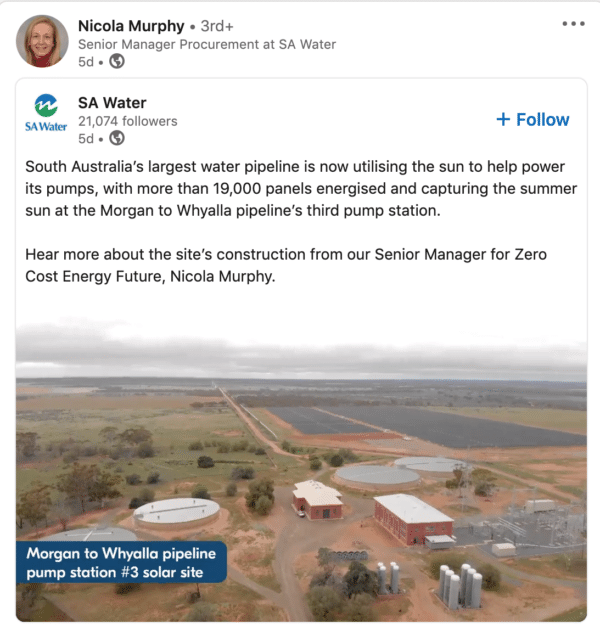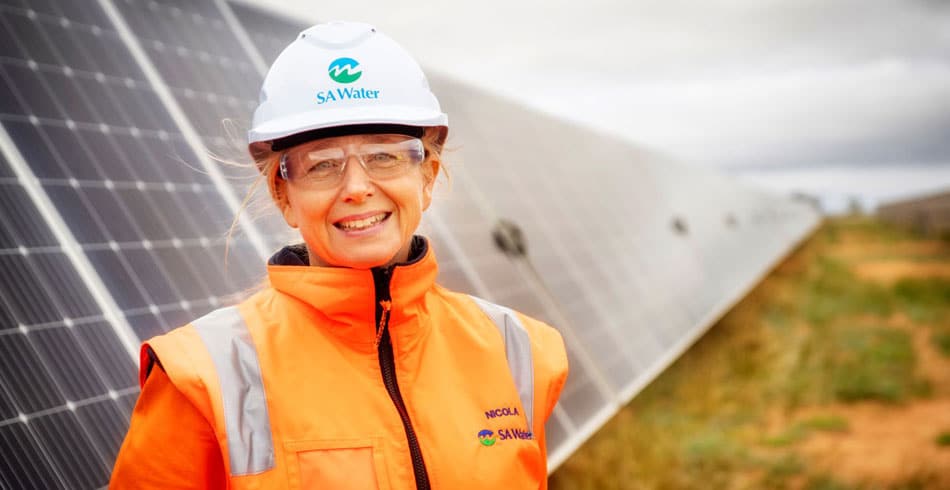You may not be able to taste the sunlight, but the 7.5 MW solar plant built to power the third pumping station on South Australia’s Morgan-Whyalla pipeline, which delivers drinking water from the Murray River to the Upper Spencer Gulf region, has been energised and is now moving water, participating in Australia’s National Electricity Market, and contributing to the masterplan for SA Water’s zero-cost energy future.
Drinking water in South Australia typically has to travel a long way from source to water treatment to tap. The four pumping stations involved in transporting water from the Murray River to tens of thousands of customers in the Barossa Valley, Riverland, Mid North and Upper Spencer Gulf zones of the network propel the vital supply along a pipeline 358 kilometres long.
“The energy requirements to pump such volumes of water are significant,” said SA Water’s Senior Manager Zero Cost Energy Future, Nicola Murphy in a statement celebrating the third milestone in this particular piece of SA Water’s $300 million solar rollout.
More than half a million solar panels and 34 MWh of energy storage will be installed as part of the water utility’s ambitious agenda to neutralise the energy costs of its operations.
Outlined at this time last year, the plan has progressed in leaps and bounds despite social distancing required of workforces under Covid-19 conditions.
On the Morgan-Whyalla pipeline, pump stations 1 (5.5 MW) and 2 (5.5 MW) have already been completed, and only the final leg of the water’s journey remains to be powered by solar — pump station 4 (also 5.5 MW) is expected to be complete in mid-2021.

Solar power paying it forward
No. 3 pump station, at the prettily named Geranium Plains is the subject of the current justified gushing.
Murphy explains that each of the 19,000 panels in this array is supported by a pivoting racking system that tilts the panels to track the sun from east to west during the day. “The direct current (DC) voltage captured by the panels is converted into high-voltage alternating current (AC) energy,” before it “travels underground to a connection point for use at the pump station.”
Any excess electricity generated by the plant will be sold on the national electricity spot market, says Murphy, and the generated income will further help to reduce the costs of operating SA Water’s system.
The utility’s water and wastewater operations are one of South Australia’s biggest electricity consumers: its cost of energy for the 2019-2020 financial year totalled approximately $86 million.
More than 160,000 solar panels have already been installed as part of SA Water’s Zero Cost Energy Future initiative, at sites such as the Bolivar Wastewater Treatment Plant (19.24 MW) and the Adelaide Desalination Plant (15.5 MW).
When complete, the deployment of a total of 500,000 solar panels will also result in emissions reductions “equivalent to planting more than seven million trees, or removing more than 30,000 motor vehicles from the road” for every year they operate, Murphy proudly says.
Of course, the planned renewable-energy-powered water system flows also into South Australia’s overall intention, declared in 2015, to achieve net-zero emissions by 2050.
A drop in SA’s bucket of renewable aspirations
In December 2020, the South Australian Government Climate Change Action Plan 2021-2025 further ramped up the state’s ambitions, charting “a proud bipartisan pathway towards decarbonisation”, as David Speers, the SA Minister for Environment and Water wrote in the forward.
It heralded a scenario in which the state’s transformation to a net-zero-emissions economy, and to concurrently becoming a national and international exporter of clean energy could lead it to generate a volume of renewable energy more than 500% of its current local grid demand by 2050.
SA Water is contributing to such goals, one drop and one solar panel at a time, while ensuring it keeps water prices ““low and stable for our customers across the state”, Murphy said.
This content is protected by copyright and may not be reused. If you want to cooperate with us and would like to reuse some of our content, please contact: editors@pv-magazine.com.









By submitting this form you agree to pv magazine using your data for the purposes of publishing your comment.
Your personal data will only be disclosed or otherwise transmitted to third parties for the purposes of spam filtering or if this is necessary for technical maintenance of the website. Any other transfer to third parties will not take place unless this is justified on the basis of applicable data protection regulations or if pv magazine is legally obliged to do so.
You may revoke this consent at any time with effect for the future, in which case your personal data will be deleted immediately. Otherwise, your data will be deleted if pv magazine has processed your request or the purpose of data storage is fulfilled.
Further information on data privacy can be found in our Data Protection Policy.